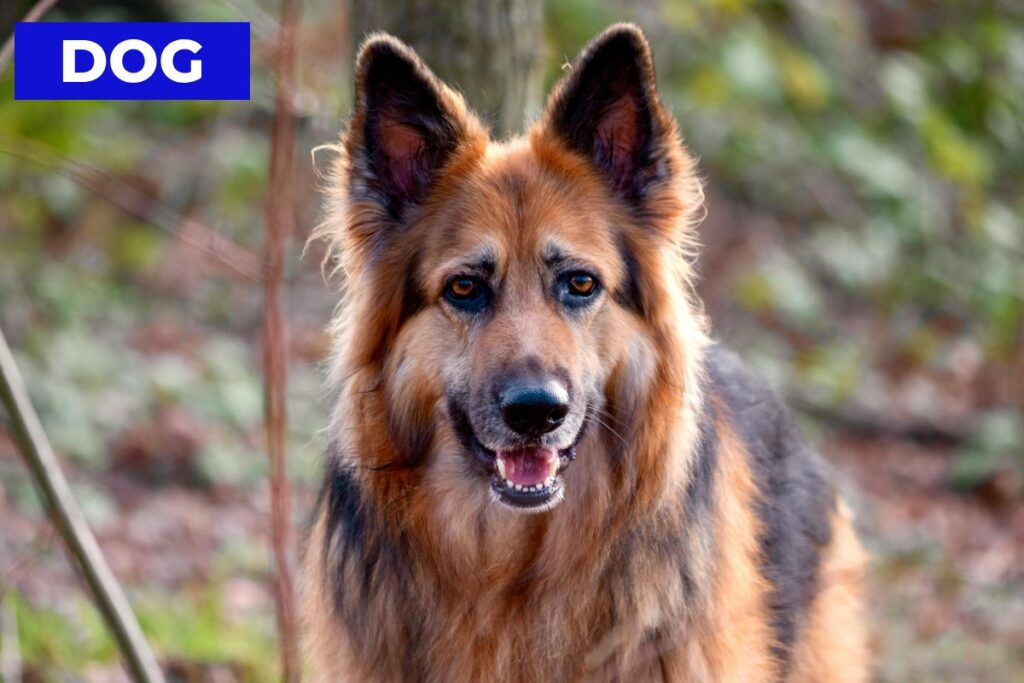
What is a Dog?
The dog (Canis familiaris or Canis lupus familiaris) is a remarkable species with deep ties to human history.
They have been a central part of human society for thousands of years, and their unique bond with humans is unlike that of any other species.
Domesticated over 14,000 years ago, dogs stand as the first species humans successfully tamed. They have evolved alongside us, serving multiple roles in our daily lives.
From hunting to companionship, dogs have adapted to fulfill numerous roles in human societies, showcasing incredible versatility, intelligence, and loyalty.
This article delves into the fascinating world of dogs, exploring their anatomy, behavior, breeds, and enduring relationship with humans.
Origin and Domestication of Dogs
The dog’s ancestry traces back to the gray wolf (Canis lupus). Genetic evidence suggests that dogs are the domesticated descendants of wolves, specifically from an ancient, now-extinct wolf population.
Domestication likely began when wild wolves started scavenging near human camps, a process known as the commensal pathway.
Over time, these wolves became more accustomed to humans, and a symbiotic human-wolf relationship emerged. Genetic studies also suggest that the domestication of dogs might have begun over 25,000 years ago, possibly in Siberia.
However, domestication was not a singular event. It was a prolonged process that unfolded over thousands of years.
Wolves and early dogs continued to interbreed, creating various canid populations. Eventually, dogs became distinct from their wild ancestors, taking on roles that wolves could not fulfill.
The earliest confirmed remains of a domesticated dog date back to around 14,223 years and were found in Germany.
The remains were buried alongside humans, indicating that dogs were already considered companions during that era. While some evidence suggests that domestication might have occurred earlier, the exact timeline remains debated among researchers.
The Evolution of Dog Breedss played a significant role in shaping the dog’s evolution. Through selective breeding, they enhanced traits that would benefit their societies.
Early dogs assisted in hunting, guarding, and herding. As human needs diversified, so did the variety of dog breeds.
By the beginning of the Bronze Age, five distinct types of dogs had emerged. These types included the mastiffs, wolf-type dogs, sight hounds, pointing dogs, and herding dogs.
Each of these breeds fulfilled specific functions, from guarding livestock to tracking game over vast distances.
Taxonomy and Classification
Dogs belong to the family Canidae, which includes wolves, foxes, and other wild canids. They are classified as a subspecies of the gray wolf (Canis lupus), with the scientific name Canis lupus familiaris.
Despite their close genetic relationships, dogs and wolves have significant behavioral and physiological differences due to selective breeding and domestication.
Carl Linnaeus, the Swedish botanist and zoologist, formally classified dogs in 1758. He distinguished dogs from wolves based on physical characteristics, such as the dog’s upturned tail, which is not present in wolves.
Over time, scientists have refined this classification, but dogs are still generally considered a subspecies of the gray wolf.
Ecology and Population
The global dog population is estimated to be between 700 million and 1 billion, with dogs found in nearly every corner of the world.
In many developed countries, dogs are primarily kept as pets, with a significant portion of households owning at least one dog.
In contrast, a large percentage of dogs in developing countries are feral or community dogs, living independently or semi-independently from humans.
Feral dogs often form packs and can pose challenges to local ecosystems, particularly in areas where they compete with native wildlife for resources.
In some regions, feral dogs are considered invasive species and are subject to population control measures to protect endangered animals.
Efforts to control dog populations often involve spaying and neutering programs, as well as adoption initiatives aimed at reducing the number of stray and unwanted dogs.
These programs are essential in managing dog populations and ensuring that all dogs receive proper care and shelter.
Breeds and Diversity of Dogs
One of the most striking aspects of dogs is their incredible diversity. There are around 450 officially recognized dog breeds, making dogs the most variable species in terms of size, shape, and behavior.
This diversity is largely the result of selective breeding, which began in earnest during the Victorian era.
Breeds are typically grouped based on their purpose, such as hunting, herding, guarding, or companionship.
For example, retrievers like the Labrador are bred for their ability to retrieve game, while herding dogs like Border Collies excel at managing livestock.
Each breed has distinct traits, both physically and behaviorally, that make them suited for specific tasks.
Despite their differences, all dogs share certain anatomical features. They have the same number of bones (except for variations in the tail), and all dogs possess a highly developed sense of smell, superior hearing, and strong jaws with 42 teeth.
Reproduction and Breeding of Dogs
Dogs are mammals, meaning they give birth to live young and nurse them. They typically reach sexual maturity between six months and two years, depending on the breed. However, larger breeds may take longer to mature.
The reproductive cycle of a dog consists of several stages. This includes estrus, commonly known as being “in heat,” during which females are receptive to mating.
Female dogs can have two to three estrous cycles per year, with each cycle lasting about three weeks.
Gestation lasts about 63 days, after which the female gives birth to a litter of puppies. Litter sizes can vary greatly depending on the breed, with smaller breeds typically having fewer puppies than larger breeds.
Breeding dogs is a complex process that requires careful consideration of genetics, health, and temperament.
Selective breeding has been used for centuries to enhance desirable traits in dogs, such as size, coat type, or working abilities.
This has led to the development of specialized breeds, each with its own unique characteristics and abilities.
However, this practice can also lead to health problems, particularly in breeds that have been subjected to inbreeding or extreme physical traits.
Neutering or spaying is a common practice to prevent unwanted pregnancies and reduce the risk of certain health issues, such as uterine infections or testicular cancer.
Neutering can also have behavioral benefits, such as reducing aggression or marking behaviors in male dogs.
Dog Anatomy: Structure and Function
Dogs, one of the most diverse species on the planet, display remarkable anatomical variation across their breeds.
Despite their vast differences in size, all healthy dogs share a similar skeletal structure, with the exception of variations in their tails.
This common skeletal framework supports the many physical traits and abilities that make dogs such agile, adaptable animals.
Their skeletal structure, for instance, is built for running, with flexible shoulders and long ribs that provide ample space for their heart and lungs.
Additionally, their vertebrae are designed to support powerful back muscles, aiding in speed and agility.
Dogs Size and Skeletal Differences
The size range among dog breeds is astonishing. One of the largest breeds, the Great Dane, can weigh between 50 to 79 kg (110 to 174 lbs) and stand 71 to 81 cm (28 to 32 inches) tall.
In contrast, the Chihuahua, one of the smallest breeds, weighs as little as 0.5 kg (1.1 lbs) and stands just 13 to 20 cm (5 to 7.9 inches) tall.
Despite this size disparity, the internal skeletal structure remains consistent across breeds, with variations primarily in bone length and density.
The dog’s skeleton is designed for flexibility and movement, allowing them to run and change direction quickly.
The vertebrae in their neck and back have extensions where strong muscles connect, including epaxial and hypaxial muscles.
These muscles give dogs the power and flexibility to run, jump, and play with ease. Their long ribs create ample space for the heart and lungs, making them well-suited for endurance activities.
It worth noting that over thousands of years, selective breeding has modified the dog’s skeleton, adapting certain breeds for specific tasks.
For example, mastiffs have larger, more powerful skeletons, while smaller breeds like terriers were miniaturized for agility.
Dwarfism, a trait selectively bred into breeds like the Dachshund and Corgi, results in shorter legs, making them ideal for tasks such as hunting in burrows or herding livestock.
Skull Structure and Teeth of Dogs
The dog’s skull structure varies significantly between breeds, even though all dogs share the same basic components.
There are three main types of skull shapes: dolichocephalic (elongated), mesocephalic (intermediate), and brachycephalic (short and broad).
Dolichocephalic skulls, seen in sighthounds, are long and narrow, optimized for speed and vision. Mesocephalic skulls, found in breeds like Labradors, represent the average skull shape.
Brachycephalic skulls, seen in breeds like Bulldogs, are short and broad, often leading to breathing challenges due to compressed nasal passages.
Dogs develop two sets of teeth—baby teeth and permanent teeth. They have around 42 teeth, designed primarily for tearing and consuming meat.
Their carnassial teeth are particularly important for cutting food into manageable pieces. These teeth are located toward the back of the mouth and are highly effective at slicing through flesh.
The Dog’s Tail: Function and Importance
A dog’s tail is an extension of its vertebral column, typically composed of 26 vertebrae. However, some breeds, due to selective breeding, have significantly fewer tail vertebrae.
The tail serves multiple purposes, from aiding in balance to communication. When a dog tilts to one side, its tail helps counterbalance the body, making fast turns and agile movements more stable.
Additionally, the tail plays a critical role in communication, signaling a dog’s emotional state through wagging and positioning.
Most dogs naturally have 26 vertebrae in their tails, though some breeds have far fewer due to selective breeding.
Dogs also use their tails to spread scent from their anal glands, marking their territory. Some breeds possess a violet gland, located on the dorsal surface of the tail, which secretes a smell that can communicate with other dogs.
In some cases, this gland can enlarge due to conditions like Cushing’s disease, causing hair loss and bald spots.
Genetic Variations and Tail Docking
Some dogs are born with naturally short tails due to a genetic mutation in the T gene, resulting in a “bobtail.”
These dogs do not require docking because of their naturally shortened tails. While tail docking remains a controversial practice, evidence suggests it may prevent certain injuries in working dogs.
However, studies indicate that docking would need to be performed on hundreds of dogs to prevent a single tail injury, raising ethical concerns about the practice.
Dog Coat
The dog coat plays a crucial role in protecting the animal from environmental elements. It comes in various lengths and textures, depending on the breed.
There are three primary types of dog coats: short, medium, and long.
Examples of short-coated breeds include the Doberman Pinscher and Pointer, while medium coats are found on breeds like the Siberian Husky.
Long-coated breeds, such as the Chow Chow and Maltese, require more maintenance.
Within these coat categories, hair can be coarse or fine, further distinguishing different breeds. Besides texture, colour and distribution are important factors, especially in breed standards.
Many dog breeds have specific colour requirements that influence breeding decisions. For instance, a Dalmatian’s distinct black spots are a defining feature of the breed.
Seasonal Shedding and Coat Growth
Most dogs shed their coats seasonally, a natural process influenced by daylight. As days shorten in the fall, a dog’s coat becomes thicker and longer.
This thickened coat helps protect dogs from the colder weather. In contrast, spring initiates the shedding process, preparing the dog for warmer months. This is why dogs shed more during springtime.
Temperature also plays a role in coat growth. Dogs in colder climates grow thicker coats compared to those in warmer regions.
However, dogs in warmer climates may still develop a protective undercoat, though it will be less dense.
The topcoat or the length of furnishings on areas like the ears and tail is less affected by temperature.
These natural cycles ensure that the dog is well-prepared for environmental changes.
Importance of Regular Grooming
Grooming is essential for maintaining a dog’s coat and overall health. Regular grooming enhances the dog’s appearance and provides opportunities to check for skin issues.
Not only does it remove dirt and loose hair, but it also stimulates blood circulation. Grooming can be a relaxing and bonding experience for both the dog and its owner.
The dog’s coat acts as a protective barrier between the skin and the environment. Proper grooming ensures that this barrier remains clean and functional.
It also helps prevent matting in longer-haired breeds, which can lead to skin infections. Regular brushing keeps the coat healthy and shiny, improving both the dog’s comfort and appearance.
Sensory Capabilities of Dogs
One of the most remarkable aspects of dogs is their extraordinary sense of smell. Dogs have up to 300 million olfactory (scent) receptors, compared to about six million in humans.
This makes their sense of smell up to 100,000 times more sensitive than that of humans.
Dogs possess a heightened olfactory ability that enables them to detect scents imperceptible to humans.
This remarkable sense of smell makes them excellent hunters and trackers and invaluable in various roles, including search and rescue, detection of explosives, and medical diagnosis.
In addition to their sense of smell, dogs also possess acute hearing. They can detect frequencies between 40 Hz and 60 kHz, far surpassing the human range of 20 Hz to 20 kHz.
This heightened auditory sensitivity enables them to hear high-pitched sounds and detect even the faintest of noises.
Dogs excel at picking up on potential threats or prey, such as the ultrasonic calls of rodents, due to this keen sense of hearing.
Their sense of vision, however, is not as developed as humans. Dogs are not color-blind but dichromatic, meaning they can only see shades of blue, yellow, and gray.
They also have poorer visual acuity compared to humans but compensate with a wider field of vision and superior night vision due to the high number of rod cells in their retinas.
Behavioral Traits and Intelligence
Dogs exhibit a wide range of physical characteristics, with over 400 recognized breeds today.
The smallest breed, the Chihuahua, can weigh as little as 2 pounds and stand only 5 inches tall. In contrast, the Irish Wolfhound, one of the tallest breeds, can reach over 30 inches in height.
Despite these differences, all dogs share several common traits.
Dogs are known for their intelligence and social nature, traits that have been honed through thousands of years of selective breeding.
Their ability to understand and respond to human commands is unparalleled among non-human animals.
Some breeds, such as Border Collies and Poodles, are particularly renowned for their problem-solving abilities and trainability.
Communication in dogs is multifaceted, involving a combination of vocalizations, body language, and scent marking.
Dogs use barks, growls, and whines to express a range of emotions, from excitement to aggression. Their body language, including tail position, ear movement, and posture, also conveys important information about their emotional state.
One of the most studied aspects of dog behavior is their unique bond with humans. Dogs are highly attuned to human emotions and can even read human facial expressions.
This ability to understand human cues has led to the development of numerous roles for dogs in human society, including therapy, assistance for the disabled, and emotional support.
Tail-Wagging and Communication
A fascinating aspect of dog anatomy is the way their tails communicate emotions. Research has shown that dogs wag their tails asymmetrically in response to different stimuli.
Positive stimuli often provoke a right-sided wag, while negative stimuli may cause a left-sided wag. This subtle difference can help other dogs or humans gauge the dog’s emotional state.
However, dogs can sometimes injure their tails by wagging too forcefully, a condition known as “kennel tail” or “happy tail.”
This is most common in hunting dogs or those with long, strong tails. In some breeds, tail docking—removing part of the tail—is traditionally done to prevent such injuries.
However, many animal welfare organizations, including the American Veterinary Medical Association, oppose tail docking, arguing that the procedure causes unnecessary pain and distress.
The Digestive System and Diet
Dogs are carnivores, though they can survive on a varied diet. Their digestive systems are designed to process meat efficiently, but they can also digest plant-based food to some extent.
Wild dogs and their ancestors primarily consumed animal proteins, but domesticated dogs have adapted to include grains and vegetables in their diet.
A dog’s digestive system is relatively short, allowing them to process food quickly. This is an adaptation from their wild ancestors, who needed to consume and digest food rapidly to avoid competition from other predators.
Today, dogs’ diets are carefully managed by their owners. Commercial dog food is formulated to provide balanced nutrition, including proteins, fats, vitamins, and minerals.
However, some owners opt for a raw or homemade diet, which mimics the natural diet of wild canids.
Roles in Human Society
Throughout history, dogs have served humanity in diverse roles, from working animals to beloved companions.
Initially bred for specific tasks like hunting and herding, their keen senses made them indispensable assets.
As societies evolved, dogs adapted, becoming protectors of homes and livestock. Breeds like mastiffs were specifically developed for their protective instincts and strength.
Today, while some dogs still fulfill these traditional roles, many are cherished pets, providing companionship and emotional support.
In modern times, dogs continue to serve society in various capacities. Working dogs assist in law enforcement, search and rescue operations, and even therapy.
The bond between humans and dogs is one of the most well-studied interspecies relationships. Owning a dog has numerous physical and emotional benefits, including stress reduction, lower blood pressure, and improved overall well-being.
Dogs are also utilized in therapy settings to aid individuals struggling with mental health conditions such as anxiety and depression.
Beyond companionship, dogs play crucial roles in law enforcement, search and rescue, and military operations.
Their exceptional sense of smell enables them to detect explosives, narcotics, and even certain diseases. In the military, dogs are invaluable in detecting landmines and other dangers, saving countless lives.
Dogs as Pets
In addition to their working roles, dogs are beloved pets in many households. Their loyalty, affection, and companionship make them ideal companions for people of all ages.
Owning a dog has been shown to reduce stress, improve mental health, and encourage physical activity.
However, owning a dog also comes with responsibilities. Dogs require regular exercise, proper nutrition, and veterinary care to ensure their well-being.
Training is also essential to help dogs understand boundaries and behave appropriately around humans and other animals.
The Importance of Training and Socialization
Training is essential for ensuring that a dog behaves appropriately in different situations. Basic obedience training, such as teaching a dog to sit, stay, and come when called, helps establish boundaries and strengthens the bond between dog and owner.
Socialization is equally important, especially for puppies. Exposing a dog to different people, animals, and environments at a young age helps prevent fear and aggression.
Well-socialized dogs are more confident and better equipped to handle new experiences.
Positive reinforcement is the most effective training method for dogs. This approach rewards good behavior with treats, praise, or play, encouraging the dog to repeat the desired behavior.
Harsh punishment or physical corrections can damage the trust between a dog and its owner and may lead to behavioral problems.
Health and Care for Dogs
The health of dogs is a critical aspect of their care, and maintaining their well-being is a priority for any responsible owner.
Regular veterinary check-ups are essential for preventing and diagnosing health issues early. Vaccinations protect dogs from dangerous diseases, such as rabies, distemper, and parvovirus.
A balanced diet is crucial for a dog’s overall health. Dogs require a mix of proteins, fats, and carbohydrates, along with vitamins and minerals.
Commercial dog food is formulated to meet these nutritional needs, but some owners may choose to prepare homemade meals.
It’s important to consult with a veterinarian to ensure that a dog’s diet is appropriate for its breed, age, and activity level.
Exercise is another key component of a dog’s health. Regular physical activity helps maintain a healthy weight, strengthens muscles, and prevents behavioral problems.
The amount of exercise a dog needs depends on its breed and size. For example, working breeds like Border Collies require more exercise than smaller, less active breeds like Pugs.
Common Ailments in Dogs
Dogs are susceptible to a wide range of diseases and health conditions. These can vary from minor issues to life-threatening diseases.
Some of the most common health issues include respiratory diseases, heart conditions, gastrointestinal problems, and musculoskeletal disorders.
They are also susceptible to include ear infections, dental disease, and skin allergies. Moreover, some breeds are also prone to specific genetic disorders due to inbreeding, such as hip dysplasia in large breeds or respiratory issues in brachycephalic breeds.
These conditions can often be prevented or managed with proper care and regular veterinary check-ups.
More serious conditions, such as hip dysplasia, cancer, and heart disease, are also prevalent in certain breeds. Hip dysplasia is common in large breeds like German Shepherds and Labradors.
It’s a genetic condition that affects the hip joint, causing pain and mobility issues. Early diagnosis and treatment can help manage the condition and improve a dog’s quality of life.
Cancer is another major health concern for dogs, especially in older animals. Certain breeds, such as Golden Retrievers and Boxers, are more prone to developing cancer.
Regular health screenings can help detect cancer early, increasing the chances of successful treatment.
Heart disease is also common in dogs, particularly in small breeds like Cavalier King Charles Spaniels. Symptoms of heart disease include coughing, difficulty breathing, and fatigue.
Medications and lifestyle changes can help manage the condition and extend a dog’s life.
Aging in Dogs
As dogs age, their needs change. Senior dogs may experience mobility issues, weight gain, or dental problems.
Adjusting their diet to include joint supplements and switching to softer food can help ease these issues. Regular veterinary visits become even more important as dogs grow older, as early detection of age-related health problems can improve a dog’s quality of life.
Owners should also be mindful of a dog’s mental health as they age. Cognitive dysfunction, similar to dementia in humans, can affect older dogs.
Symptoms include confusion, restlessness, and changes in behavior. Keeping an older dog mentally stimulated through play, training, and engagement can help delay cognitive decline.
Lifespan of Dogs
On average, dogs live between 10 to 13 years, although smaller breeds tend to live longer than larger ones. Factors such as diet, exercise, and regular veterinary care can significantly impact a dog’s lifespan.
In recent years, advances in veterinary medicine have led to improved health outcomes for dogs, with treatments available for many previously fatal conditions.
Vaccination is an essential part of dog health care, protecting them from common diseases such as rabies, canine distemper, parvovirus, and leptospirosis.
Regular check-ups with a veterinarian can help detect and prevent potential health issues early, ensuring that dogs live long, healthy lives.
Final Note
For thousands of years, dogs have evolved alongside humans, transforming from wild wolves into loyal companions.
This enduring relationship has shaped their evolution and continues to influence their future.
From their flexible skeletons to their expressive tails, every aspect of a dog’s body is adapted for survival, communication, and companionship.
They have developed unique abilities and traits, making them one of the most versatile and beloved animals on Earth.
Dogs have played significant roles in human society for millennia. From hunting and herding to providing emotional support and companionship, they have cemented their place as “man’s best friend.”
Understanding their unique traits, behaviors, and needs is crucial for ensuring their well-being.
Whether as working animals or beloved pets, dogs enrich our lives in countless ways. Their loyalty, affection, intelligence, and adaptability have made them indispensable to human societies worldwide.
This enduring bond makes them one of the most cherished animals in history.
Finally, understanding a dog’s physical structure not only helps us appreciate their incredible diversity but also informs how we care for and interact with these loyal companions.
At Facts and Tips, we strive for accuracy and honesty. If you notice any errors, whether factual, editorial, or outdated information, please don't hesitate to contact us.






